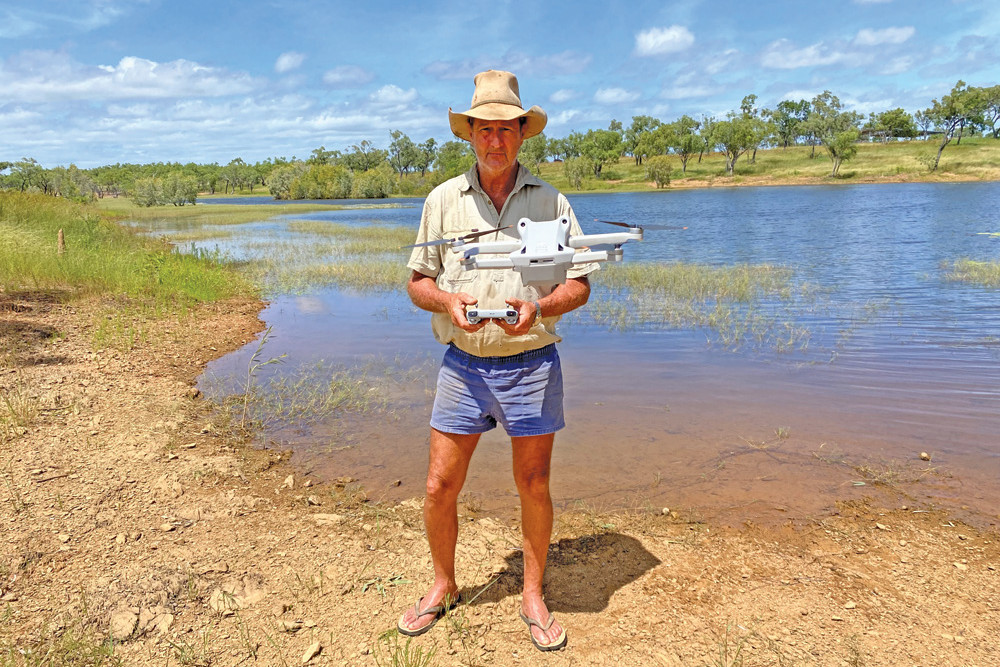General News
15 April, 2023
Mustering into the future
Seasoned cattleman’s vision of a new era on the land. A BOOM in technology on local farms is making the lives of those living on the land easier, including seasoned cattleman Alan Pedersen who is one of many embracing new ways of doing things.

One of the ways technology is being used is the introduction of drones on cattle stations which gives graziers the option to put the compact aircraft into flight and track down cattle in half the time a helicopter can.
Although helicopters are still the number one choice when it comes to mustering, Alan, who is the owner of the massive Karma Waters station north-west of Chillagoe, believes the ease and efficiency of the new technology will greatly benefit his cattle operations.
“We have got a drone, but they will never replace helicopters entirely,” he said.
“They can be used as a spotting tool and you can just put them up and spot cattle but when it comes down to actually mustering cattle in Savannah country, it is very difficult, especially in hilly country.”
Being able to fly through unreachable places is one of the great benefits of his DJI Mini 3 Pro drone, as helicopters and musterers on horseback or in motor vehicles struggle to get into certain parts of the property.
Although it cannot physically move the animal, the drone helps Alan and his workers to easily track down the beasts hiding between trees or in hilly areas and take the next steps to bring them home.
“What moves cattle with the helicopters is the noise and the downdraft – so if you were to sit under a helicopter that is about 50 metres up, the noise and the downdraft gets you going if you are a cow,” he said.
“Helicopters are often very busy with two or three different mobs of cattle that can be far back, and you can miss a few of them but with a drone, you can work in conjunction with the helicopter to help spot cattle hiding in bushes.”
Spotting cattle isn’t the only benefit drones are bringing to Alan’s station, with the device proving to be useful during recent heavy rain which caused several rivers and causeways to flood on the property.
Sending the drone out over waterways, Alan can now take photographs of damage on his property and where water has blocked entries and exits throughout floods, allowing him to monitor them until they can be repaired.
In the past, the drone has also been used to find trespassers on his property camping and pig hunting, with the information taken from the drone used when contacting police.
As technology progresses into the new age, Alan envisions a variety of different technologies being implemented into the station, including a microchip like device imbedded into cattle.
“I think the one thing that would help most in the future are ‘ceres tag’, which is basically a tag with a solar panel on them and it helps you track them,” he said.
“On country, those tags last about 10 minutes because there is a lot of timber that the cattle get into to scratch them out of their ear.
“I think they need to turn those big things into a chip like a dog or horse. That’s when you start talking because then there will come a day when my boys (station workers) will be able to just tap their computer screens and then zoom in on the cattle through satellite and be able to say, for argument’s sake, ‘that’s 12431, she was born here, and she was branded that way’.”
Having the cattle’s history connected to the chip will also ease the process of selling the animals, with graziers given the ability to see the quality of cattle from its history.
Communication technology has also help create more efficiency during mustering, with simple texts and emails now replacing telegrams via the Royal Flying Doctor Service to UHFC radio.
With a device as simple as a mobile phone or laptop, Alan believes technology will help the industry boom and create important collaborations when it comes to mustering.
“You sent telegrams and that was your only form of communication back then (when he started the business),” Alan said.
“If you wanted to tell your neighbour when you were mustering, you would have to work it out two months in advance and write them a letter which they would get two weeks later and then they’d had to write back to you again.
“Now you can just pick up your mobile phone and send them a text or email.”


